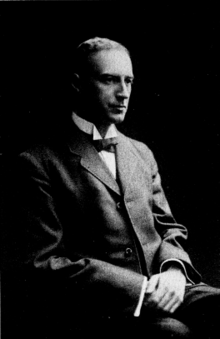Wallace Clement Sabine
Wallace Clement Sabine (born June 13, 1868 - † January 10, 1919 ) was an American physicist and pioneer in the field of room acoustics .
Live and act
Sabine studied at Ohio State University and graduated in 1886 at the age of only 18. He then began graduate studies at Harvard University , but never did his Ph.D. Nevertheless, he got a physics professorship at Harvard. Since they were dissatisfied with the acoustics of a new classroom, Sabine was asked to investigate. From 1910 to 1915 he developed the basics of room acoustics. He also founded the Riverbank Acoustics Laboratory in Geneva, Illinois , which was later expanded into a premier acoustics laboratory by his distant cousin Paul Sabine . He calculated the acoustics for the Symphony Hall in Boston and the Fogg Lecture Hall.
Wallace Clement Sabine was the first to develop parameters for reverberation time , sound absorption and sound transmission in buildings. The Sabin unit of measurement for sound absorption is named after him.
The Sabine equation for the reverberation time is one of the most important tools for the quantitative description of the acoustics of a room:
in which
- the reverberation time
- the volume of the sonicated room
- is the total absorption area of the room.
This formula, empirically found by Sabine, was theoretically derived in 1929 by the physicists Kurt Schuster and Erich Waetzmann and, independently of that, in another way by Carl F. Eyring .
In 1894 Sabine was elected to the American Academy of Arts and Sciences , in 1917 to the National Academy of Sciences .
Fonts
- Collected Papers On Acoustics Cambridge: Harvard University Press, 1923
Individual evidence
- ↑ Sabine von Fischer: The acoustic argument. Science and listening experience in 20th century architecture . gta Verlag, Zurich 2019, ISBN 978-3-85676-354-1 , p. 50-54 .
- ^ Acoustics Engineering: WC Sabine
| personal data | |
|---|---|
| SURNAME | Sabine, Wallace Clement |
| BRIEF DESCRIPTION | American physicist and acoustician |
| DATE OF BIRTH | June 13, 1868 |
| DATE OF DEATH | January 10, 1919 |




